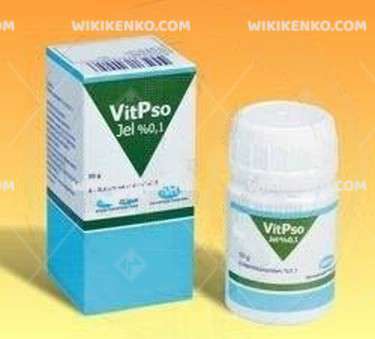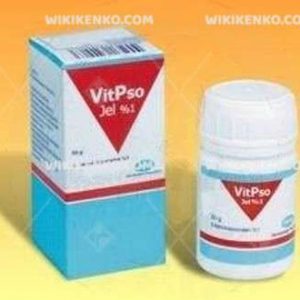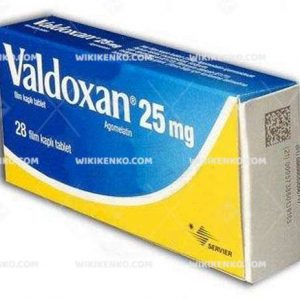Vitpso Gel %0.1
In the realm of dermatology, where science and medicine converge, Vitpso Gel %0.1 stands as a beacon of hope for individuals grappling with various skin conditions. This comprehensive guide illuminates the key aspects of this topical medication, from its composition to applications and vital precautions.
| Dosage form | |
|---|---|
| Pack size | |
| Potency | %0.1 50G |
| Manufacturer | |
| Origin | |
| Generic Name (Ingredient) | Within 1 Gram Of Gel: 8-Methoxyporal (Metoxaline) 1 Mg |
Assuming your emergency circumstances for this product, visit Urgent Quotation page. Besides, for any pharmaceutical questions, please ask us in the comments section.
Description
Vitpso Gel %0.1, a topical medication, finds its niche among drugs categorized as topical psoralens. At its core lies the active ingredient, 8-Metoksipsoralen (Metoksalen), with each gram of the gel containing 1 mg of this compound.
Mechanism
8-Metoksipsoralen, the powerhouse within Vitpso Gel %0.1, elevates the sensitivity of skin cells to artificial (UVA) rays or sunlight. This heightened sensitivity results in cellular damage and a reduction in tissue growth rate.
8-Metoksipsoralen
Also recognized as Methoxsalen, 8-Metoksipsoralen boasts a natural origin, found in the seeds of the Ammi majus (Umbelliferae) plant and the roots of Heracleum Candicans. Classified within the psoralens family, or furocoumarins, Methoxsalen plays a pivotal role in addressing conditions like psoriasis, eczema, vitiligo, and certain cutaneous lymphomas.
Methoxsalen’s Versatility
Methoxsalen isn’t confined to a single purpose. It’s a pivotal component in the arsenal against severe psoriasis and finds its place in combination with UVA light therapy. Its usage extends to mycosis fungoides, generalized lichen planus, photodermatosis, and cutaneous mastocytosis.
Applying Vitpso Gel %0.1
The application of Vitpso Gel %0.1 is straightforward—apply it topically, directly onto the skin. It presents itself as a transparent, homogeneous gel with a characteristic odor, slightly yellowish in color. Each plastic bottle contains 50 g of this therapeutic gel.
Auxiliary Substances
Besides the star of the show, 8-Metoksipsoralen, Vitpso Gel %0.1 incorporates a lineup of auxiliary substances. These include Polyethylene glycol 400, Propylene glycol, Polyquaternium-10, Ethanol, and Pure water, all contributing to its formulation.
Precautions
Vitpso Gel %0.1 should be administered exclusively by a qualified medical practitioner, cautioning against self-use. It becomes a no-go zone for individuals with sensitivities to 8-Metoksipsoralen or any other components within Vitpso.
Conclusion
In conclusion, Vitpso Gel %0.1, fortified with 8-Metoksipsoralen, emerges as a potent weapon in the dermatologist’s arsenal. Its applications span a spectrum of skin conditions, underscoring its versatility. However, the path to effective and safe usage begins with professional guidance, emphasizing the pivotal role of healthcare providers in this therapeutic journey.
| Topic | Details |
|---|---|
| Active Ingredient | 8-Metoksipsoralen (Metoksalen) |
| Formulation | Topical Gel |
| Concentration | 0.1% |
| Auxiliary Substances | Polyethylene glycol 400, Propylene glycol, Polyquaternium-10, Ethanol, Pure water |
| Application | Topical |
| Smell and Color | Characteristic odor, Slightly yellowish |
| Packaging | 50 g plastic bottles |
| Precautions | Administered by healthcare provider, Avoid use if sensitive to 8-Metoksipsoralen or other ingredients |
In your pursuit of optimal skin health, remember that your trusted healthcare provider stands as your guiding light, ensuring that Vitpso Gel %0.1 is harnessed effectively and safely for your benefit
1 review for Vitpso Gel %0.1
Use the form below to report an error
Please answer the questions as thoroughly and accurately as possible. Your answers will help us better understand what kind of mistakes happen, why and where they happen, and in the end the purpose is to build a better archive to guide researchers and professionals around the world.
The information on this page is not intended to be a substitute for professional medical advice, diagnosis, or treatment. always seek the advice for your physician or another qualified health provider with any questions you may have regarding a medical condition. Always remember to
- Ask your own doctor for medical advice.
- Names, brands, and dosage may differ between countries.
- When not feeling well, or experiencing side effects always contact your own doctor.
Cyberchondria
The truth is that when we’re sick, or worried about getting sick, the internet won’t help.
According to Wikipedia, cyberchondria is a mental disorder consisting in the desire to independently make a diagnosis based on the symptoms of diseases described on Internet sites.
Why you can't look for symptoms on the Internet
If diagnoses could be made simply from a textbook or an article on a website, we would all be doctors and treat ourselves. Nothing can replace the experience and knowledge of specially trained people. As in any field, in medicine there are unscrupulous specialists, differences of opinion, inaccurate diagnoses and incorrect test results.





Shayma –
Good